Glue and You: How to stick bits together with science.
One recurring theme that occurs for new players is what supplies are appropriate for wargaming. There are a lot of different supplies out there, and it can be overwhelming for a new player. In this article, we will try and cover the different types of glues available and what applications they are well suited for.
Type of Glue: "Super Glue" (cyanoacrylate based glues). Brands include: Citadel, Krazy Glue, generic shop glues
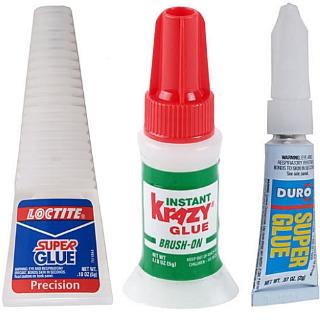
How it works: Super glue is probably the most commonly used glue and every househould is likely to have a tube somewhere. You put down a drop of it on your surface, and press the other piece\bit into. It absorbs moisture from the air and after a few seconds (30, usually) you have a soft set and can let go. It's pretty thin and can run easily, so a dispenser with a precision tip is best.
What it's used best for: General model assembly.
Things to watch out for: Super glues are very strong but also very brittle. As a result, the bonds can shatter easily if you drop a model, or if you twist a part. This is actually useful when you want to break a bond (say, for stripping an old model) - by putting the model in the freezer for a little bit, you can easily shatter the bond by twisting.
Additionally, superglues can fog or "craze" clear parts. When gluing clear parts, such as canopies, you will wish to use clear parts glue instead.
Where you can get it: Games Workshop, Hardware stores, supermarkets, pharmacies. Note that many people report in the forums with alarming regularity that the base "Citadel superglue" sold at Games Workshop stores is of inferior quality and should likely be avoided.
GWS has recently released new formulations of superglue, which come in a gel and thin type - this warning does not apply to these glues, with which there are no reviews as of this writing.
Type of product: Gel-Style superglues (Loctite Ultra, Gorilla Glue Superglue)
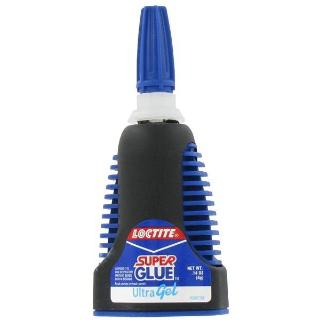
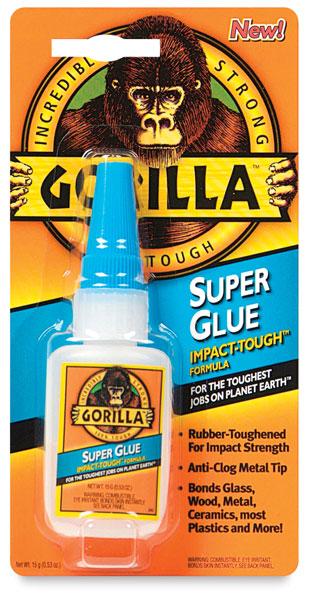
How it works: It's pretty much the same as superglues, above. However, it's a lot thicker, so it doesn't run.
What it's used best for: This is my general go-to glue. It's very strong, you have a little but of time before it sets to work it, and it kicks quite nicely. Since it's thick, it can also be used to fill gaps - if you sprinkle some baking soda on this stuff when wet, it makes a rock-solid, sandable gap filler. It's also impregnated with rubber, so it's a little bit less brittle than normal superglue.
While Gorilla Glue Superglue is not actually a "gel", it's very similar in all respects to the Loctite Ultra, down to the rubber impregnation. Many modeler's on this site swear by the Gorilla Glue Superglue, and I use it interchangeably with the Loctite Ultra.
Things to watch out for: There are no special concerns for gel-type superglues, it has all the same pitfalls as normal superglue. As a side note, for the Loctite specifically, after it appears to be "empty", you can carefully slice off the plastic shell. Inside you will find a toothpaste-style dispenser and it usually is still half full!. However, you must be careful with your slicing, as it's very easy to nick the tube with the hobby knife and ruin it.
For the Gorilla Glue Superglue, not that it's not normal Gorilla Glue. Just plain "Gorilla Glue" is a completely different product, which totally different uses and properties (it also come sin much larger containers, which should tip you off it's different!). Normal Gorilla Glue is great for fixing broken crockery and household uses, but does not have any useful applications for building wargaming models - you have to wet the target surfaces and clamp them because it expands. It's probably good for scenery, but Liquid Nails is just as good and a lot simpler to use.
Where you can get it: Home stores such as Lowe's and Home Depot. Possibly office supply stores. Amazon usually has it but at an enormous markup - it's around $6 at Lowe's and $11 on Amazon as of this writing.
Type of product: Kicker
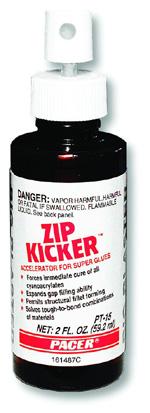
How it works: Usually this comes in a spray bottle. When you take some wet superglue\gel joins and spray them with this, they cure instantly.
What it's used best for: Assembling models quickly.
Things to watch out for: If you have an large refill bottle, keep it capped; it evaporates quickly. The refill bottles are more economical that buying the spray bottles.
If you're using this when assembling terrain you built yourself, such as foamcore board or insulation foam, beware that most brands of kicker will dissolve\eat the exposed styrofoam. You can either protect the styrofoam by painting it with thin coats of watered-down PVA glue, or you can buy kicker that is explicitly marked as foam-safe .
.
Where you can get it: Amazon.com , Hobbylinc
, Hobbylinc , Tower Hobbies
, Tower Hobbies , better hobby shops.
, better hobby shops.
Type of product: Clear Parts Glue
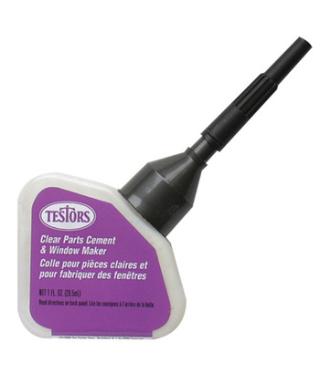
How it works: Just apply a little bit with the applicator, and let it air dry. It will be milky but dry transparent.
What it's used best for: Clear parts, such as canopies, lenses, etc.
Things to watch out for: This glue is not as resilient as other glue and really is for just clear parts.
Where you can get it: Most hobby shops will have this, if they sell plastic model kits; such as Hobby Lobby or Michaels. Amazon.com
Type of product: PVA glue: Elmers Glue, School Glue
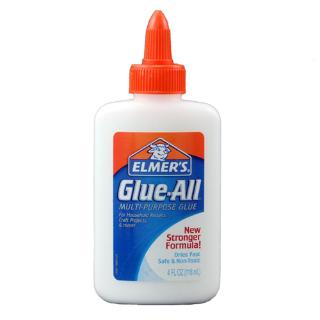
How it works: This glue is made from milk byproducts and dries clear when very thin, but in thicker drips can get cloudy
What it's used best for: Terrain. This is really great for assembling foamcore, or cut insulation terrain, right out of the bottle. It's also idea for basing - add some water to it, 2 parts glue to 1 part water, and paint bare plastic bases with it, then sprinkle play sand on them and let dry overnight.
Things to watch out for: It takes a little longer to dry then you'd think and really should b left to dry overnight for thick layers even if it appears dry.. It's also pretty flexible. It should not be used on actual miniatures.
Where you can get it:Games Workshop, Hardware stores, supermarkets, pharmacies. As common as superglue. Beware that the Citadel PVA glue you can buy in Games Workshop stores is horrifically overpriced; a trip to a home store can usually buy a gallon of this for less than GWS charges for a few ounces.
Type of product:Plastic Model Cement
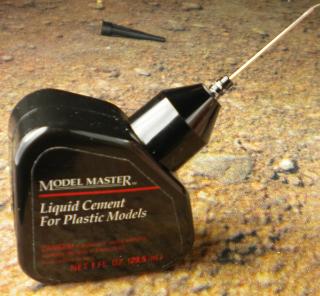
How it works: Cement is a clear, thin, redolent fluid that often comes in a needle-tipped applicator as shown. It doesn't work like other glues here, but instead works more like a welder: after applying the glue, hold the parts together for a few seconds. The glue chemically attacks the plastic, melting the pieces together. Needs about 2 hours to cure, but on styrene to styene it bonds near-instantly and you can continue working with your kit after about a minute.
What it's used best for: I like to use it for large joins, such as on the insides of vehicles. When you use this and place the needle into a crack in the plastic, a gentle application will carry the glue the entire run of the seam via capillary action. This glue is also significantly less likely to have a clog since it doesn't air-dry, but if it does, a thin gauge wire can be used to clear it.
Things to watch out for: Since it melts plastic, obviously you don't want to drip it anywhere on your model! It will leave an outline of a drop within literally seconds. So apply carefully. It also will not work on metal or resins, obviously.
Where you can get it: Most places that sell plastic model car kits will also carry this. Hobbylinc
---
Type of product: 2 part epoxy, multipart epoxies
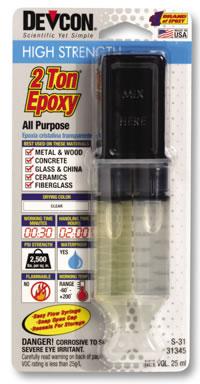
How it works: These usually come in a twin-linked syringe that dispenses equal parts of epoxy and catalyst when you depress it. You should depress this onto a scrap piece of cardboard or index card, and then mix it and apply with a toothbrush. The 2 parts chemically interact with each other and harden. The time for this to cure varies by the brand and formulation, but it usually a few hours; 4 or so is common. The bonds are very strong and usually totally permanent.
What it's used best for: Assembling very large models, heavy models. Candidates for this would be Thunderhawks and other resin superheavies, as well as large metal models with thin\low surface area mating points (such as wings). This type of glue will always require pins be drilled and inserted between the target surfaces (and possibly even clamped for really large points) - until this glue dries it has absolutely no "sticking power".
Things to watch out for: Wear gloves. For some reason no matter how careful you are it tends to get all over your hands, and it's totally immune to soap. It's not really irritating to your skin, in my experience,but getting the uncured glue on yourself is very annoying and will leave tacky spots for a day or two until it wears of. Obviously if you get some uncured glue on your model, it's nigh-impossible to remove. So be careful.
Where you can get it: Home stores, such as Lowe's, Home Depot, Amazon .
.